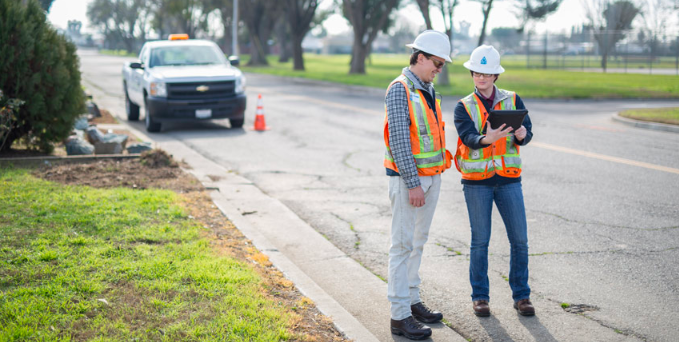
What is a Road Safety Audit?
Road Safety Audits (RSAs) are in-depth evaluations of current or planned road projects, concentrating on crash potential and safety performance. They proactively identify risks and focus on preventing serious injuries and fatalities within the Safe System Framework. Unlike standard compliance checks, RSAs offer a holistic approach to road safety, ensuring thorough assessment throughout the infrastructure lifecycle.
Who Conducts a Road Safety Audit?
RSAs are performed by audit teams consisting of at least two accredited auditors who meet local competency requirements. For unbiased assessments, especially for new or modified designs, it is essential that the audit team is independent of the design team. Each audit task must be led by a senior road safety auditor. RedSquare Traffic’s team of traffic engineers are Accredited Senior Road Safety Auditors, and we are a DTP Prequalified Organisation under the Road Safety Auditing category.
Scope of Road Safety Audits
RSAs can be applied to a broad spectrum of road types and scenarios, including new constructions, road treatments, and pedestrian and bicycle lanes. The specific risks identified will depend on the project being audited.
When Are Road Safety Audits Conducted?
Road Safety Audits are applicable at various project stages, from feasibility through to operation. Conducting audits during feasibility and preliminary design phases provides the most significant benefits, as they help enable modifications to the design while there is still flexibility in the design process.
Types of Road Safety Audits
1. Feasibility Stage Road Safety Audits
Purpose and Importance:
Feasibility stage audits, also known as strategic or concept audits, are conducted during the initial planning stages of a project. These audits integrate safety considerations into early decision-making, ensuring safety is a fundamental component from the outset.
Key Features:
- Risk Identification: Highlights potential safety issues that could arise from the proposed project.
- Prevention Focus: Stresses preventive measures to avert future safety problems.
- Strategic Integration: Ensures safety considerations are embedded into the overall project strategy.
Application:
Feasibility stage audits are vital for large-scale infrastructure projects, such as new highways or urban development plans, where early intervention can significantly influence the project’s overall safety performance.
2. Concept/Functional Road Safety Audits
Purpose and Importance:
Concept or functional design audits are conducted during the early design phases of a project. These audits ensure that the preliminary design aligns with safety objectives and addresses potential hazards before detailed design work begins.
Key Features:
- Preliminary Safety Assessment: Reviews the basic design for safety risks.
- Design Optimization: Recommends changes to enhance safety outcomes.
- Stakeholder Involvement: Involves stakeholders early to incorporate safety feedback.
Application:
These audits are particularly beneficial for urban road projects where elements like intersections, pedestrian crossings, and bicycle lanes require thorough evaluation to improve safety for all road users.
3. Detailed Design Road Safety Audits
Purpose and Importance:
Detailed design audits take place once the project’s design has been largely finalized. These audits ensure that all safety features are thoroughly reviewed and that the design complies with safety standards before construction begins.
Key Features:
- Comprehensive Review: Detailed examination of all design aspects, including road geometry, signage, and lighting.
- Compliance Check: Ensures adherence to relevant safety standards and guidelines.
- Risk Mitigation: Identifies and mitigates any remaining safety risks.
Application:
Detailed design audits are critical for complex projects such as freeway interchanges and major arterial roads, where precise design can significantly impact road safety.
4. Pre-Opening Road Safety Audits
Purpose and Importance:
Pre-opening audits are conducted just before a road is opened to the public. These audits ensure that all safety measures have been implemented correctly and that the road is safe for use.
Key Features:
- Final Safety Check: Verifies that all safety features are in place and functioning as intended.
- Operational Readiness: Assesses the road’s readiness for traffic.
- Immediate Corrections: Identifies any issues that need immediate attention before opening.
Application:
These audits are essential for all new road projects, from major highways to local streets, ensuring that the road is safe for public use from day one.
5. Post Implementation Road Safety Audits
Purpose and Importance:
Post implementation audits are conducted within three months of the road opening. These audits assess the effectiveness of the implemented safety measures and identify any immediate safety issues that have arisen since the road became operational.
Key Features:
- Early Performance Assessment: Evaluates how the road is performing in real-world conditions.
- Issue Identification: Detects any early-stage problems that need addressing.
- Continuous Improvement: Provides feedback for ongoing safety improvements.
Application:
Post implementation audits are vital for all new road projects, helping to ensure that the road continues to operate safely after opening.
6. Existing Conditions Road Safety Audits
Purpose and Importance:
Existing conditions audits are performed on roads that have been in use for more than three months. These audits assess the ongoing safety performance of the road and identify any changes needed to enhance safety.
Key Features:
- Ongoing Monitoring: Regularly evaluates the safety performance of existing roads.
- Adaptive Management: Adjusts safety measures based on current conditions and usage patterns.
- Long-Term Safety: Ensures sustained safety improvements over the road’s lifecycle.
Application:
Existing conditions audits are critical for maintaining the safety of the road network, particularly in areas with high traffic volumes or frequent changes in road conditions.
7. Worksite Traffic Management Road Safety Audits
Purpose and Importance:
Worksite traffic management audits focus on the safety of temporary traffic management measures at construction sites. These audits ensure that the worksite is safe for both workers and road users.
Key Features:
- Temporary Safety Measures: Evaluate the effectiveness of temporary traffic control measures.
- Worker and Public Safety: Ensures that safety protocols protect both workers and the public.
- Compliance and Best Practices: Verifies compliance with relevant safety standards and best practices.
Application:
Worksite traffic management audits are essential for any road construction or maintenance project, ensuring that safety is maintained during temporary changes to traffic patterns.
Conclusion
Road Safety Audits (RSAs) are an indispensable tool for enhancing road safety in Australia. By systematically evaluating road projects at various stages, from feasibility to post-implementation, RSAs ensure that safety is a fundamental consideration throughout the lifecycle of a road project. These audits not only help in identifying and mitigating potential safety risks but also promote a culture of safety awareness among all stakeholders involved in road infrastructure development.
Post a comment Cancel reply
Related Posts
Traffic Engineer in the Lifecycle of a New Development
When you think about what makes a development project successful, you might picture architects,…
AS2890.1: Off-Street Parking Facilities
In Australia, one of the key documents guiding the design and construction of off-street facilities…
Insights into Types of Road Safety Audits
What is a Road Safety Audit? Road Safety Audits (RSAs) are in-depth evaluations…
Understanding Clause 52.34: Bicycle Facilities
In today’s urban landscapes, promoting sustainable modes of transportation is significant. Clause 52.34 of…










